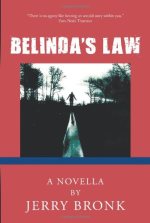Title: Belinda’s Law
Author: Jerry Bronk
Publisher: Trafford
ISBN: 978-1466996274
Pages: 168, Paperback/Kindle
Genre: Fiction
Reviewed by: Russell D. James, MA, MLIS, Pacific Book Review
Book Review
Belinda’s Law is a delightful examination of the life situation of a cast of characters who are just as normal as the readers of the book. There are no super-hero archetypes or super-villain devils lurking in the shadows to take over the story line and make the book about anything more than the everyday struggles we all go through in life. The contemporary basic, normal fiction that Jerry Bronk presents the readers gives new light to old themes: living, loving, working, playing, dreaming. There are few surprises in life and this book presents a narrative remembering by the main character of a life lived and played in reality, not fantasy.For such a short book (even short in novella standards), there are many twists and turns that take place and that come out of the woodwork in the same means as termites coming out of hiding in a wall to find a piece of classic furniture to devour. While devouring the pages, these same twists and turns lend nicely to a story that presents a portion of each of us to the reader.
This reviewer was taken to a part of the United States that he had never been to fall in love with people he had never met, dreaming of the story and what might happen next while taking a break from reading. This book really has no setting other than the lives of almost everyone who might read the book. And the names of the characters could easily be substituted with our own names, or the names of people we know or have known throughout our lives. Keeping to reality and remembering that this book is fiction and not a “true crime” type of novel about a man, his daughter, and the people around them, is very difficult. Reality seems to mix with fantasy in a dreamscape that one would not remember when waking up, but remember vividly when trying to fall asleep.
Although typesetting is a major issue for this book (it just looks so unprofessional) and the typeface itself is so small that even this reader with normal eyesight needed to squint to keep up with the gentle flow of the writing. Although the author uses the semicolon too much (and most of the time incorrectly), there are no editing issues that would prevent this book from being sold commercially or marketed to audiences who like a good late-twentieth slash early-twenty-first century story about regular people doing regular things in a mess created by other regular people doing regular things.
I finished this book wondering what was next. Will there be a sequel? Will there be a book written by Belinda or another character that tells the story in a different way? Will I, the reader, write a continuation of the book just to finish the story in my own mind, a mind that no longer seems normal but instead a bit demented?


